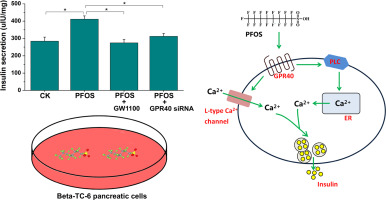当前位置:
X-MOL 学术
›
Sci. Total Environ.
›
论文详情
Our official English website, www.x-mol.net, welcomes your
feedback! (Note: you will need to create a separate account there.)
Perfluorooctane sulfonate acute exposure stimulates insulin secretion via GPR40 pathway.
Science of the Total Environment ( IF 8.2 ) Pub Date : 2020-04-07 , DOI: 10.1016/j.scitotenv.2020.138498 Lianying Zhang 1 , Xiaoyu Duan 2 , Weijie Sun 2 , Hongwen Sun 2
Science of the Total Environment ( IF 8.2 ) Pub Date : 2020-04-07 , DOI: 10.1016/j.scitotenv.2020.138498 Lianying Zhang 1 , Xiaoyu Duan 2 , Weijie Sun 2 , Hongwen Sun 2
Affiliation

|
Perfluoroalkyl substances (PFASs) are widely used synthetic chemicals, showing environmental/biological persistence and adverse effects on ecosystem and human health. Several epidemiological and animal studies have revealed that PFASs levels are associated with elevated serum insulin level; however, the effect of PFASs on insulin secretion and the underlying mechanism are not clear. In this study, the effect of a most concerned PFAS, perfluorooctane sulfonate (PFOS) on insulin secretion in Beta-TC-6 pancreatic cells was studied. The results showed that PFOS acute exposure stimulated insulin secretion and elevated intracellular calcium concentration ([Ca2+]i). The PFOS-stimulated [Ca2+]i elevation was resulted from both extra- and intra-cellular sources. PFOS acute exposure decreased ATP content and ATP/ADP ratio, indicating the mitochondrial function was damaged under PFOS acute exposure. The PFOS-stimulated insulin secretion was inhibited by GW1100, a G Protein-coupled Receptor 40 (GPR40) specific inhibitor, but not affected by GW9662, a specific antagonist to the peroxisome proliferator-activated receptor gamma (PPARγ). The observation of RNA silencing further demonstrated that the PFOS-stimulated insulin secretion is, at least partially, via GPR40. By using specific inhibitors, we found that the GPR40 downstream pathways, phospholipase C (PLC) and L-type Ca2+ channels (LTCC) were involved in PFOS-stimulated [Ca2+]i elevation and insulin secretion.
中文翻译:

全氟辛烷磺酸盐急性暴露通过GPR40途径刺激胰岛素分泌。
全氟烷基物质(PFAS)是广泛使用的合成化学品,显示出环境/生物持久性以及对生态系统和人类健康的不利影响。几项流行病学和动物研究表明,PFAS的水平与血清胰岛素水平的升高有关。但是,PFAS对胰岛素分泌的作用及其潜在机制尚不清楚。在这项研究中,研究了最关注的PFAS全氟辛烷磺酸盐(PFOS)对β-TC-6胰腺细胞胰岛素分泌的影响。结果表明,PFOS急性暴露刺激胰岛素分泌和细胞内钙浓度([Ca2 +] i)升高。PFOS刺激的[Ca2 +] i升高是细胞外和细胞内来源引起的。PFOS急性暴露降低了ATP含量和ATP / ADP比,表明在全氟辛烷磺酸急性暴露下线粒体功能受到损害。PFOS刺激的胰岛素分泌被GW1100(G蛋白偶联受体40(GPR40)特异性抑制剂)抑制,但不受GW9662(过氧化物酶体增殖物激活受体γ(PPARγ)的特异性拮抗剂)的影响。RNA沉默的观察进一步表明,PFOS刺激的胰岛素分泌至少部分是通过GPR40。通过使用特定的抑制剂,我们发现GPR40下游途径,磷脂酶C(PLC)和L型Ca2 +通道(LTCC)与PFOS刺激的[Ca2 +] i升高和胰岛素分泌有关。过氧化物酶体增殖物激活受体γ(PPARγ)的特异性拮抗剂。RNA沉默的观察进一步表明,PFOS刺激的胰岛素分泌至少部分是通过GPR40。通过使用特定的抑制剂,我们发现GPR40下游途径,磷脂酶C(PLC)和L型Ca2 +通道(LTCC)与PFOS刺激的[Ca2 +] i升高和胰岛素分泌有关。过氧化物酶体增殖物激活受体γ(PPARγ)的特异性拮抗剂。RNA沉默的观察进一步表明,PFOS刺激的胰岛素分泌至少部分是通过GPR40。通过使用特定的抑制剂,我们发现GPR40下游途径,磷脂酶C(PLC)和L型Ca2 +通道(LTCC)与PFOS刺激的[Ca2 +] i升高和胰岛素分泌有关。
更新日期:2020-04-08
中文翻译:

全氟辛烷磺酸盐急性暴露通过GPR40途径刺激胰岛素分泌。
全氟烷基物质(PFAS)是广泛使用的合成化学品,显示出环境/生物持久性以及对生态系统和人类健康的不利影响。几项流行病学和动物研究表明,PFAS的水平与血清胰岛素水平的升高有关。但是,PFAS对胰岛素分泌的作用及其潜在机制尚不清楚。在这项研究中,研究了最关注的PFAS全氟辛烷磺酸盐(PFOS)对β-TC-6胰腺细胞胰岛素分泌的影响。结果表明,PFOS急性暴露刺激胰岛素分泌和细胞内钙浓度([Ca2 +] i)升高。PFOS刺激的[Ca2 +] i升高是细胞外和细胞内来源引起的。PFOS急性暴露降低了ATP含量和ATP / ADP比,表明在全氟辛烷磺酸急性暴露下线粒体功能受到损害。PFOS刺激的胰岛素分泌被GW1100(G蛋白偶联受体40(GPR40)特异性抑制剂)抑制,但不受GW9662(过氧化物酶体增殖物激活受体γ(PPARγ)的特异性拮抗剂)的影响。RNA沉默的观察进一步表明,PFOS刺激的胰岛素分泌至少部分是通过GPR40。通过使用特定的抑制剂,我们发现GPR40下游途径,磷脂酶C(PLC)和L型Ca2 +通道(LTCC)与PFOS刺激的[Ca2 +] i升高和胰岛素分泌有关。过氧化物酶体增殖物激活受体γ(PPARγ)的特异性拮抗剂。RNA沉默的观察进一步表明,PFOS刺激的胰岛素分泌至少部分是通过GPR40。通过使用特定的抑制剂,我们发现GPR40下游途径,磷脂酶C(PLC)和L型Ca2 +通道(LTCC)与PFOS刺激的[Ca2 +] i升高和胰岛素分泌有关。过氧化物酶体增殖物激活受体γ(PPARγ)的特异性拮抗剂。RNA沉默的观察进一步表明,PFOS刺激的胰岛素分泌至少部分是通过GPR40。通过使用特定的抑制剂,我们发现GPR40下游途径,磷脂酶C(PLC)和L型Ca2 +通道(LTCC)与PFOS刺激的[Ca2 +] i升高和胰岛素分泌有关。











































 京公网安备 11010802027423号
京公网安备 11010802027423号